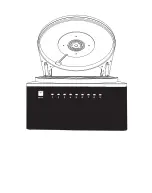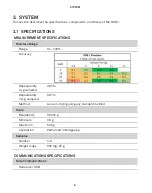
11
ROS 1
3.3 THEORy
The Bridge app user matches any reference moisture method without the need to use
extreme temperatures to predict the moisture content. ROS 1 has a growing list of standard
configurations based on AOAC, AACC, and Swiss Food Manual standards. The ROS 1 calculates
moisture on a dry basis.
Percent Moisture on a Wet Basis (% wb, g/100 g total)
Percent Moisture on a Dry Basis (% wb, g/100 g solids)
% Moisture
=
x 100 =
initial weight – dry weight
initial weight
grams of water
100 grams total
% Moisture
=
x 100 =
initial weight – dry weight
dry weight
grams of water
100 grams total
Many food applications report moisture contents on a wet basis. A simple equation converts
between the wet and dry basis.
% moisture wet
=
x 100
% moisture dry
100 –
% moisture dry
% moisture dry
=
x 100
% moisture wet
100 –
% moisture wet
3.3.1 INTRODUCTION TO MOISTURE CONTENT
Two measures are required to completely describe the state of water in a product: water
activity and moisture content. Water activity is a measure of the water’s energy. It has a
sound thermodynamic basis and can be exactly specified and measured. Moisture content,
on the other hand, must be defined operationally, since there is no way to actually determine
the exact amount of water in a sample.
One way to determine moisture content is to measure the difference between the mass of
a sample and its mass in a reference state. The reference state is generally specified as the
state of the sample after it is placed in an oven at a specified temperature for a specified
time. This state is often assumed to be a state of 0 moisture content, but it is not. Increasing
the oven temperature or decreasing the oven vapor pressure will result in additional mass
loss from the sample, and some of that mass loss will be water. Some mass loss may be from
vaporization of other volatiles present in the sample or oxidization of sample constituents.
The uncertainty from these two sources (tightly bound water remaining in the dry sample
and nonwater mass loss from the sample) leads some to use the term moisture content
rather than water content to describe the result of the measurement. Whatever it is called,
the measurement provides valuable information about the state of the water in the product
and the product yield, quality, and purity. It is, therefore, important to make the measurement
as precisely as possible. The reference state needs to be carefully specified, and the
conditions that affect it must be well controlled.












































